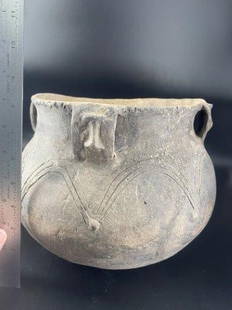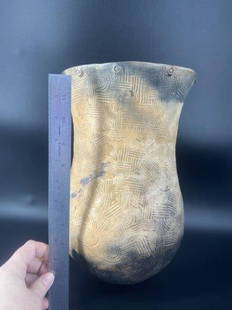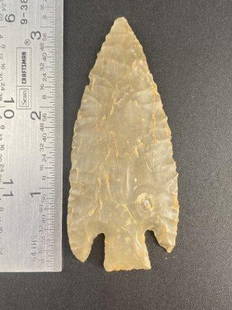
UNIDENTIFIED TLINGIT ARTIST, Chilkat Robe (Naaxein), c. 1880
Similar Sale History
View More Items in Tribal & Native American Artifacts

Related Tribal & Native American Artifacts
More Items in Tribal & Native American Artifacts
View MoreRecommended Art
View More



Item Details
Description
Lot 54
UNIDENTIFIED TLINGIT ARTIST, CHILKAT KWAAN
Chilkat Robe (Naaxein), c. 1880
mountain goat wool, yellow cedar bark and dyes, 52 x 68 in (132.1 x 172.7 cm), measurements reflect dimensions with fringe
Provenance
Equinox Gallery, Vancouver;
Private Collection, Toronto. First Arts, 28 May 2019, Lot 28;
Acquired from the above by the present Private Collection, Toronto.
The technique of twined tapestry known as Chilkat weaving (Naaxein in Tlingit) is one of the most complex styles of fabric decoration known in the world. Oral history tells us that the specialized braiding techniques that enable the weaving of circles and other rounded forms found in Northwest Coast two-dimensional design were developed by Nishga’a weavers in the Nass River valley, sometime around the latter part of the eighteenth century. Within a few generations, basic design forms had been mastered and refined into accurate reproductions of painted crest images in woven form. By the first decades of the nineteenth century, the characteristic five-sided border shape and distribution of complex formline imagery had evolved into the classic form as seen in the subject work. The weavings were made to duplicate design forms painted on wood panels with just over half of the symmetrical design represented. The weaver measures off this pattern board row by row to recreate the interconnected design forms of the painting.
Pattern boards were traditionally painted by men trained in the profession by master artists before them. Many unique patterns were used to create one-of-a-kind images in the first half of the nineteenth century, of which a number of examples survive in the world’s museums. By mid-century the pandemics of introduced diseases diminished the indigenous population, including skilled artists, and fewer unique pattern boards were being created. Single boards would be reproduced numerous times in weavings, sometimes with small changes adapted by the weaver. The lower center of the design field in this Naaxein is an example of that, where design elements from a different robe have been grafted into the mouth area of this weaving to distinguish it from others using the same or a similar original pattern. Here the design represents a diving whale; the head of the whale is shown at the bottom, and the tail across the top of the field.
Steven C. Brown
References: For a fine Chilkat Robe see First Arts, 5 Dec. 2022, Lot 52. See also Cheryl Samuel, The Chilkat Dancing Blanket, (Univ. of Oklahoma Press, 1990); see also the section on Chilkat blankets in George Thorton Emmons and Frederica de Laguna, The Tlingit Indians, (AMNH and Univ. of Washington Press, 1991) pp. 224-233. For another example see also Walker’s May 2017, Lot 53. For a robe of very similar design to the present example see Thomas Vaughan and Bill Holm, Soft Gold: The Fur Trade & Cultural Exchange on the Northwest Coast of America, p. 112. For various examples see Bill Holm, The Box of Daylight: Northwest Coast Indian Art, (Seattle, WA: Seattle Art Museum/University of Washington Press, Seattle, 1983), cats. 82-87, pp. 58-60.
UNIDENTIFIED TLINGIT ARTIST, CHILKAT KWAAN
Chilkat Robe (Naaxein), c. 1880
mountain goat wool, yellow cedar bark and dyes, 52 x 68 in (132.1 x 172.7 cm), measurements reflect dimensions with fringe
Provenance
Equinox Gallery, Vancouver;
Private Collection, Toronto. First Arts, 28 May 2019, Lot 28;
Acquired from the above by the present Private Collection, Toronto.
The technique of twined tapestry known as Chilkat weaving (Naaxein in Tlingit) is one of the most complex styles of fabric decoration known in the world. Oral history tells us that the specialized braiding techniques that enable the weaving of circles and other rounded forms found in Northwest Coast two-dimensional design were developed by Nishga’a weavers in the Nass River valley, sometime around the latter part of the eighteenth century. Within a few generations, basic design forms had been mastered and refined into accurate reproductions of painted crest images in woven form. By the first decades of the nineteenth century, the characteristic five-sided border shape and distribution of complex formline imagery had evolved into the classic form as seen in the subject work. The weavings were made to duplicate design forms painted on wood panels with just over half of the symmetrical design represented. The weaver measures off this pattern board row by row to recreate the interconnected design forms of the painting.
Pattern boards were traditionally painted by men trained in the profession by master artists before them. Many unique patterns were used to create one-of-a-kind images in the first half of the nineteenth century, of which a number of examples survive in the world’s museums. By mid-century the pandemics of introduced diseases diminished the indigenous population, including skilled artists, and fewer unique pattern boards were being created. Single boards would be reproduced numerous times in weavings, sometimes with small changes adapted by the weaver. The lower center of the design field in this Naaxein is an example of that, where design elements from a different robe have been grafted into the mouth area of this weaving to distinguish it from others using the same or a similar original pattern. Here the design represents a diving whale; the head of the whale is shown at the bottom, and the tail across the top of the field.
Steven C. Brown
References: For a fine Chilkat Robe see First Arts, 5 Dec. 2022, Lot 52. See also Cheryl Samuel, The Chilkat Dancing Blanket, (Univ. of Oklahoma Press, 1990); see also the section on Chilkat blankets in George Thorton Emmons and Frederica de Laguna, The Tlingit Indians, (AMNH and Univ. of Washington Press, 1991) pp. 224-233. For another example see also Walker’s May 2017, Lot 53. For a robe of very similar design to the present example see Thomas Vaughan and Bill Holm, Soft Gold: The Fur Trade & Cultural Exchange on the Northwest Coast of America, p. 112. For various examples see Bill Holm, The Box of Daylight: Northwest Coast Indian Art, (Seattle, WA: Seattle Art Museum/University of Washington Press, Seattle, 1983), cats. 82-87, pp. 58-60.
Condition
The absence of condition does not imply that an item is free from defects, nor does a reference to particular defects imply the absence of any others. Our team can provide thorough and comprehensive condition reports and additional images. We welcome your enquiries at info@firstarts.ca or 647-286-5012.
NOTE
Many countries prohibit or restrict importation or exportation of property containing ivory, whale bone, sealskin, and/or products derived from other endangered or protected species, and require special licenses or permits in order to import or export such property. It is the responsibility of the buyer to ensure that the item is properly and lawfully exported / imported.
NOTE
Many countries prohibit or restrict importation or exportation of property containing ivory, whale bone, sealskin, and/or products derived from other endangered or protected species, and require special licenses or permits in order to import or export such property. It is the responsibility of the buyer to ensure that the item is properly and lawfully exported / imported.
Buyer's Premium
- 23%
UNIDENTIFIED TLINGIT ARTIST, Chilkat Robe (Naaxein), c. 1880
Estimate CA$30,000 - CA$50,000
34 bidders are watching this item.
Shipping & Pickup Options
Item located in Toronto, ON, caSee Policy for Shipping
Local Pickup Available
Payment

TOP



































![UNIDENTIFIED TLINGIT ARTIST, Feast Tray, c. 1850: UNIDENTIFIED TLINGIT ARTIST Feast Tray, c. 1850 wood, 34.5 x 9 x 4.5 in (87.6 x 22.9 x 11.4 cm) unsigned; inscribed indistinctly in graphite in an unknown hand, "WSS[?] ?" Provenance Private Collectio](https://p1.liveauctioneers.com/7222/249743/129652566_1_x.jpg?height=310&quality=70&version=1653677113)








![Lakota Chief Red Cloud Arcrylic Painting By C H Keith [170818]: Framed original acrylic painting of Chief Red Cloud by Lakota painter Cecil Hobart Keith. Signed in lower right corner, CH Keith, and dated 1964. "Art critics have said that Hobart Keith's portrayals](https://p1.liveauctioneers.com/2699/331494/178785224_1_x.jpg?height=310&quality=70&version=1717094654)



















![Emilio Grau-Sala "Sur la Plage" Oil on Canvas: Emilio Grau-Sala (Spanish, 1911-1975), "Sur la Plage" [On The Beach], Oil on Canvas, 1958, signed "Grau Sala" lower right, signed, inscribed "Trouville", dated, and titled to verso. Image: 21.5" H x 2](https://p1.liveauctioneers.com/5649/328023/176731071_1_x.jpg?height=310&quality=70&version=1714409606)













